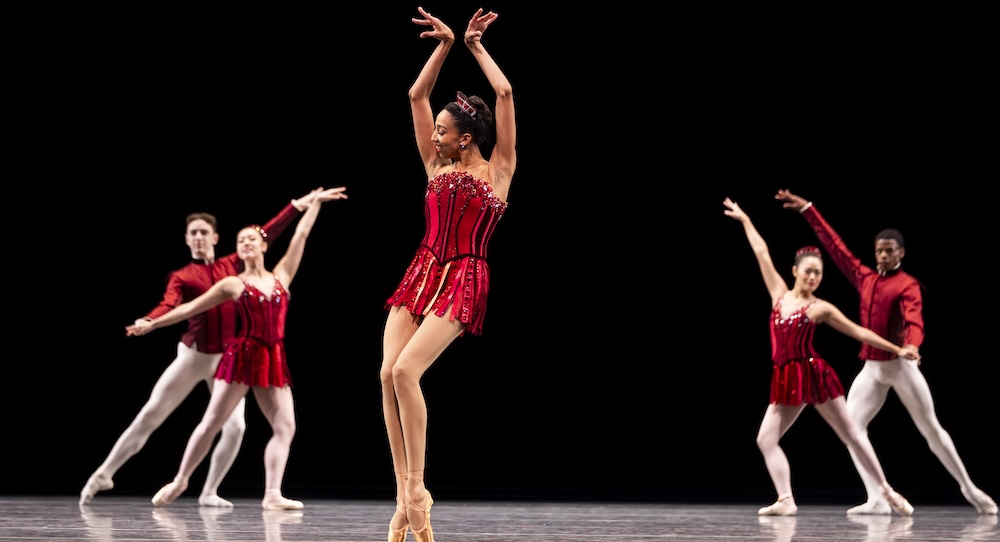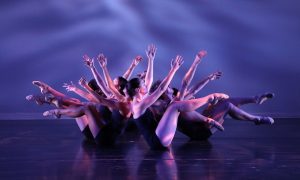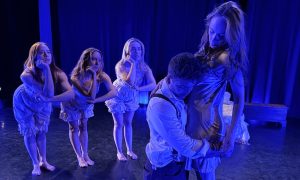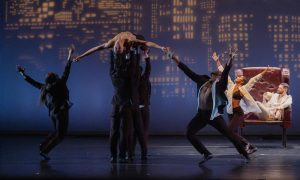October 11, 2025.
(digital access)
In 2025, George Balanchine’s work certainly may not be the most forward-thinking work out there – yet it’s inarguable that his innovations significantly shaped ballet, in America as well as worldwide, to be what it is today. From story ballets (such as The Prodigal Son and Apollo) to his plotless neoclassical works (such as Agon and The Four Temperments), his work offers a wide aesthetic range.
Jewels (1967), with three acts each presenting a different tone and feel, exemplifies such range. With commendable versatility and artistic command, the artists of Pacific Northwest Ballet brought each fully alive. The company also did so in a way that had the program harmonizing with 2025’s values and mores (which undeniably matters to modern audiences at large).
The refined, elegant “Emeralds” began with a rising overture (from Gabriel Fauré): sweet, but also with a touch of tender melancholy. Lights rose on the corps and pas de deux partners. Movement quality met the orchestral quality, with soft ease yet also the reach and release of yearning. Balanchine’s movement innovations were immediately clear: spinal release, unconventional timing structures, fresh and layered footwork. Leaning back with one arm reaching up, the dancers took up space and found wonder. Melancholy resonated, but so did hope – with both gazes and hearts lifted.
A central soloist danced with just the right meeting of technical precision and full abandon – as much rock-solid line and lift as honest pathos. It was a perfect recipe for captivation in her every kinetic nuance. A following soloist delighted with her soft lengthening and pure joyful wonder in the moving moment. A trio built even more of a refined courtly feel, with the two ballerinas and danseur luxuriating in long lines and enticingly wayward formation changes. The corps, for its part, was stately and elegant throughout. The deep green and lustrous jewels of their costumes enhanced the tasteful opulence at hand.
A following pas de deux added a pinch more drama to the same courtly atmosphere: with breath-infused lengthening, sensitive weight sharing, and highly intentional gazes. With accented lifting of lines, the next pas de deux brought pleasing playfulness into the mix. Floating ballon kept that playfulness alive until they all paused in tableau, dancers gradually re-entering until they filled the stage with the easy spaciousness of their movement quality.
Reflective and slightly mysterious melancholy returned to the ether as the energy softened to close out the piece. Even the highest opulence comes with the full range of human emotion, after all, if we humans are immersed in it.
“Rubies” began with an overture of even more dramatic mystery (from Stravinsky). Also immediately clear was an edginess and spark of personality not present in the staid, refined Emeralds. Dancers shifted hips front to back, ran with parallel rotation, and extended with flexed feet. Wrists flicked forward and back, followed by a lengthening leg. The increased speed of movement and score brought a further touch of fire and sass – all perfect for the brightness and warmth of red.
The ensemble fully met the challenge of those extra touches in the movement – of personality, of daring, of subtle sensuality – not to mention doing it all a bit faster. A memorable pas de deux offered a certain enticing slyness – one that peppered their bold eating up of the space. A following corps section kept a bit of that coyness, yet more so simply burst with ebullience: feet spritely, shapes expansive, smiles genuine and bright.
Dancers running through dynamic formation changes kept the energy omnipresent, never dying for a millisecond – until it crescendoed to a sudden tableau, all the more impactful through contrast. The ensemble’s ability to successfully deliver two very different aesthetic approaches was crystal clear – and I felt quite satisfied with both tones. As they bowed, I wondered what flavor the final section would bring.
As it were, “Diamonds“ (score from Tchaikovsky) presented both the elegance of emeralds and personality of Rubies – then added a dash of innocent sweetness. The pure gleam at hand – from the sparkling chandeliers overhead to the gems in the costumes to the dancers’ wide smiles – reflected the most fantastical girlish ballet dreams. The corps was everything those little girls want to be: effortlessly magical, flawlessly refined, and ethereally effervescent.
Heads dipped to follow the flow of legs weightlessly rising, as easy as breathing. Formations moved with the harmony of the highest, most assured attunement. A pas de deux added just a pinch of mystery and solemnity to the gleam reflecting from the stage. Indeed, wide emotional range characterizes the most classic and exalted stories and imagery, the drama of human imperfection tied up with stateliness and refinement.
On that note, the dancers’ humanity shined through their technical strength. Honest theatricality brought rich emotional life to all of the kinetic layers at hand. The smallest (and inevitable) shakes and quivers were also there to remind me that the work really is exceedingly challenging, as effortless as star dancers like these can make it look. Their close attunement made all of that even more dynamic, honest, and compelling.
As the piece proceeded, solid strength and supple lengthening came together in quite satisfying complement. Subsequent quartets kept the drama alive, unexpected paths across the stage meeting the mystery in the music to keep me wondering what could grace us in the audience next. Youthful ballet dreams can take so many different turns!
Energy continued bursting, from turns in zippy succession to floating leaps to a large ensemble lengthening limbs in quick unison. Size and speed of movement came to a climax, yet the dancers maintained understated ease; no need to force a thing (magical, fantastical dreams just happen, after all).
A final ensemble section ensured that we in the audience would leave with a sense of true grandeur and vitality – and also assurance of these dancers’ notable versatility. It also all goes back to Balanchine and his boldness; there’s a reason his works have become classics and are still danced today. These dancers, and the company at large, did his legacy proud – while also remaining honest to the cultural milieu of 2025. Brava, encora!
By Kathryn Boland of Dance Informa.















